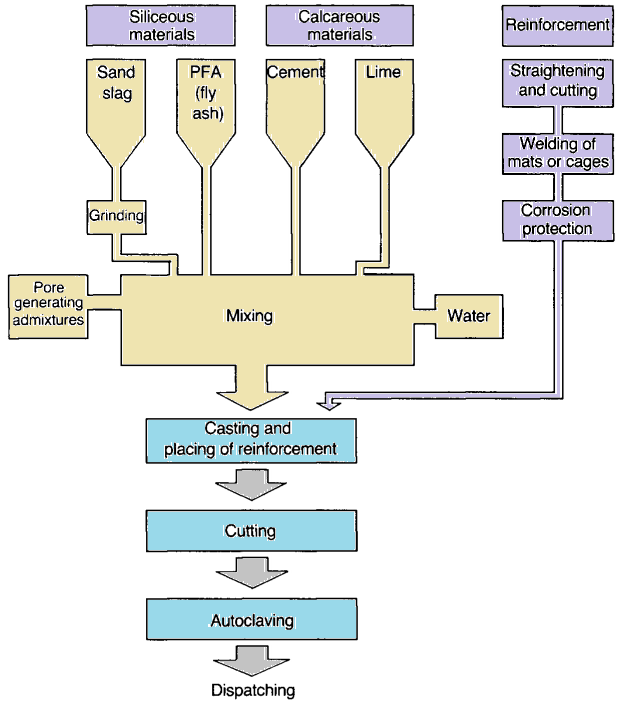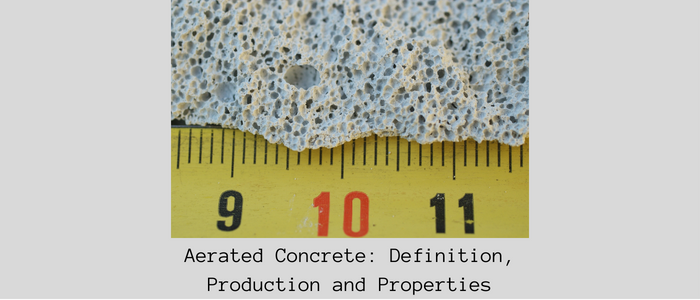What is Aerated Concrete?
Aerated Concrete is a special type of concrete that can be considered of the lightweight type. This concrete has primarily the same compounds as normal concrete such as the cement or lime, water and finely crushed siliceous sand.
The additional thing to the normal concrete is the introduction of gas bubbles into the mix. This produces a concrete that has a cellular structure that is made of voids with a size that ranges from 0.1 to 1 mm.
The shape of aerated concrete resembles the shape of sponge rubber
Note that although aerated concrete is termed as concrete, it does not actually have coarse aggregate. It is a mortar with fine aggregates in addition to air bubbles introduced.
The introduced voids should have the ability to resist the pressure incurred during mixing and compaction. Otherwise, it will not serve the purpose for which it is created.
Production of Aerated Concrete
Cement and/or lime, together with siliceous fine material (ground, if necessary) such as sand, slag or fly ash and water, are used as raw materials.
A slurry made of these ingredients is generated by adding gas (often hydrogen) or air, which causes the mixture to condense and form a homogeneous, cellular structure. The slurry of aerated concrete can develop cells in the following ways:
- Formation of gas by chemical reaction within the mass during the liquid or plastic stage;
- Adding to the slurry in the mixer a preformed stable foam;
- Entraining air by whipping;
- Other cell-forming mechanisms
Certain admixtures are required to generate the gas, or to produce the foam and to control the setting of the binder.
The mixture is poured into steel moulds and, after rising and hardening, while it is still soft, the mass is cut into the appropriate products, like as slabs or blocks.
Typically, raw materials in slurry form are fed into moulds where they rise when gas is generated by chemical reaction (see Figure 1 and 2).


Manufacturing by this process results in products with properties of low variability. This is achieved by efficient factory control systems and procedures. A general flow chart of the production process is shown in Figure 3.

It is popular to use the first and second methods in the creation of aerated concrete. Let us look at both.
1. Formation of Gas:
It is made by a chemical reaction that creates a gas in fresh mortar. This mortar has a lot of gas bubbles in it as it sets. The mortar should have the proper consistency so that the gas created may expand it without escaping. The rate of gas evolution, mortar consistency, and setting time must all be compatible.
For generating gas, the slurry is combined with finely powdered metal (often aluminium powder, often at 0.2% of the mass of the cement) and causing it to react with the calcium hydroxide released during the hydration process, it is possible to produce a significant amount of hydrogen gas. The cellular structure is provided by the hydrogen gas, which is present in the slurry mixture. In addition, zinc powder may be used in place of the aluminium powder. Metal powder has also been substituted with hydrogen peroxide and bleaching powder. But at the moment, this procedure is not frequently used.
2. Using Foam:
It is made by incorporating a foaming ingredient into the mixture during high-speed mixing, which introduces and stabilizes the air bubbles. Most frequently, resin soap or a kind of hydrolyzed protein is utilized as the foaming agent. In certain procedures, mortar is mixed with a regular mixer while stable pre-formed foam is added.
Properties of Aerated Concrete
Without sand, aerated concrete can be produced, but it can only be utilized for non-structural applications like heat insulation. Without sand, aerated concrete can range in density from 200 to 300 kg/m3. The density of the common mixes varies from 500 to 1100 kg/m3 when the aerated concrete is made from a combination of cement and very fine sand. The strength of aerated concrete changes with density similarly to other low weight concretes. Aerated concrete’s thermal conductivity changes along with density.
So, lower density grades are used for insulation, medium density grades are used to create load-bearing walls or building blocks, and relatively higher density grades are used to create prefabricated structural components that are reinforced with steel.
Read Also:
